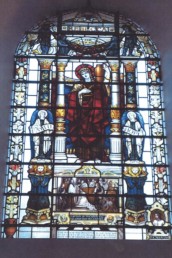Pocahontas and St George’s Church
Learn about Pocahontas’ fascinating life from her statue outside St George’s Church, then head inside to see the Rebecca stained glass window.
Choose the Instagram or Facebook button below to open the AR experience.
Aim your rear camera on the statue of Pocahontas and focus on her name to trigger the audio and visual experience.
This experience will open your camera feed. Turn your sound on to enjoy the full experience.
History
Do you know why we have this statue here?
Matoaka was born in 1595 in Werowocomoco, Virginia, America. She was the daughter of a powerful native American, Paramount Chief of the Powhatan Chiefdom Wahunsenaca, who ruled over forty native American tribes. Powhatan gave his daughter the nickname ‘Pocahontas’ meaning ‘the playful one’, which is the name most people know today.
European colonisers were travelling to America throughout Pochatonas’ childhood, and there was a great mistrust between the native American tribes and the newcomers despite initial trading. In 1607 Captain John Smith was brought before Powhatan for trespassing on native land. Pocahontas is said to have saved his life, though no proof of this sotry exists. John Smith later became leader of the settlers who built Jamestown, the first settlement in Virginia which was named after the English King, James I. John Smith returned to England in late 1609 badly wounded.
Relations between the native Americans and the settlers back in Virginia were steadily growing worse. Pocahontas was kidnapped and held ransom in Jamestown. During this time she became the first native American to be baptised, and she was given the English name ‘Rebecca’. Soon after, she gave birth to a son, Thomas, and married magistrate John Rolfe.
They lived on John’s tobacco plantation for two years. In April 1616, the Governor, Sir Thomas Dale, sailed for England, and as promised took the Rolfes with him, together with an escort of twelve native Americans. They arrived in Plymouth before travelling to London. They were received with excitement and wonder at court and Princess Pocahontas was praised for her beauty.
She spent a year in England and arrived in Gravesend in 1617 hoping to set sail for Virginia. Unfortunately she became seriously ill just offshore from Gravesend and was hurriedly returned to land where she spent her last few hours. There is still some mystery about what she died of and she was hastily buried in St. George’s Church. She was only 21. In the registers of the Parish Church of the time is found the entry: “1617. March 21st. Rebecca Wrolfe, Wyffe of Thomas Wrolfe, Gent., a Virginia Lady borne, was buried in ye Chancell.” Unfortunately the original church was destroyed in a fire in 1727, and to this day no-one has found exactly where her body lies.
Her infant son, Thomas, was taken back to London and educated by his uncle, Henry Rolfe. When he reached adulthood he sailed to America, back to the land that was his mother’s home.
Gravesend has long been a place of pilgrimage for American visitors, and the importance of Pocahontas in English history has been recognised by several ceremonies, beginning with the placing of a plaque in the church in the late nineteenth century. In 1914 a tablet and stained glass windows were donated to St. George’s Church by The National Society of the Colonial Dames of America in the Commonwealth of Virginia, and they refer to Pocahontas as “the friend of the earliest struggling colonists”. In 1958 this bronze statue of Pocahontas was unveiled by the Governor of Virginia in the St. George’s Church gardens to commemorate her life.


